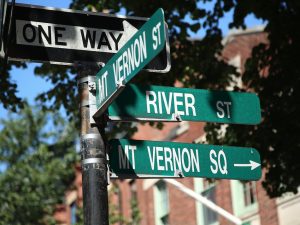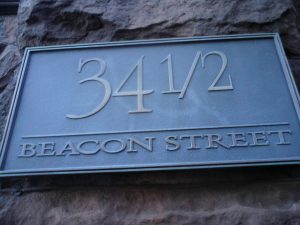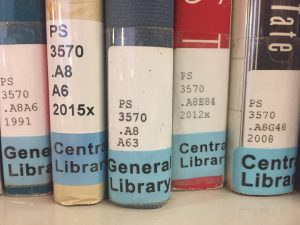If you’ve used other libraries, or even watched the PBS cartoon Arthur, you probably know most libraries don’t organize their nonfiction books by the author's name. Most libraries in the US use the Dewey Decimal System to group nonfiction by topic. If you’re an avid BPL user, you know that we actually don’t do either of those things. We use a system called Library of Congress Classification (LCC) to organize our nonfiction books. It can seem a little arcane at times, but we don’t do this to be contrary. LCC is better for very big libraries and research libraries, and BPL is both.
The baffling assortment of letters and numbers on the spine labels of our books are called call numbers. They serve as an address for the book, letting us know where to find it on the shelf. In Boston, you might live at 123 Centre Street. At the BPL, a book might live at A123. Think of the letter or letters at the front as the street name and the numbers after it as the specific street address.



You can use the online catalog to find out the call number for a specific book in our collection. There are big red flags above the nonfiction shelves in the Central Library that tell you the call numbers and subject in that area.
You don't need to know every detail of why any individual book gets the call number it does. After all, that’s why you have us friendly librarians: our job is to help you find what you need. We have lists of common subjects and their call numbers behind the desk to help find what you are looking for. If you want, this page describes what each of the 21 letter codes mean, opens a new window.
Don't try to understand call numbers, because they don't make sense. The order of the subjects is somewhat arbitrary. Similar subjects are next to each other as best as we can manage, but that breaks down quickly. It's best to assume they don't mean anything beyond being a street address.
Some subjects do happen to have letters that make sense, like M for Music or T for Technology. These are the exception rather than the rule. Once you go past that first letter, all bets are off. The same second letter and/or number code can mean totally different things in different areas. Some subjects don't have any second level letter headings at all.
For example:
- GV is the category for games and recreation.
- HV is the category for criminology.
- FV doesn't mean anything because F never has a second letter.
Don't worry about memorizing any of that, though. This is one of the reasons librarians are here to help; we took Masters level classes in understanding classification so you don't have to.
Unlike the Dewey Decimal System, which always has three digits, LCC doesn't have a set amount of digits. There is a bunch of complicated library science behind this, but it boils down to the fact that LCC doesn't use the numbers to convey meaning in the same way.
In Dewey, 123 means that the book is in the third subject of the second subcategory of the first category. Appropriately enough, 123 in Dewey is for books about Determinism. In LCC, A123 is simply the 123rd subject in class A, general works. (A123 is actually not currently a valid call number for reasons that are super complicated that you don't need to worry about right now).
For a more in-depth description, take a look at this guide made by the fine folks at the Colorado State University Library, opens a new window.


Add a comment to: What’s with all the letters and numbers? — A Very Basic Guide to Our Call Numbers